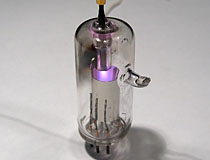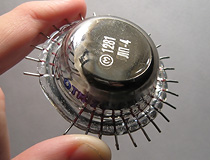This is a finger module from an IBM 604 Electronic Calculating Punch, an early computing device produced by International Business Machines. First released in 1948, the IBM 604 contained over 1200 vacuum tubes, most of which were mounted in small plug-in logic modules such as the one shown here. Programs for the 604 were written on a plugboard with removable patch cables, which would be installed in a rotating tray on the front of the machine when in operation. The IBM 604 enjoyed a long product life, with many machines working in production environments well into the 1970s.
This particular module is a TH-537, which contains two 5696 miniature xenon-filled thyratron tubes, as well as several passive components. Each tube is mounted in a socket on a metal frame, which is topped by a pull loop that would be used to unplug the module from it's backplane. Hundreds of modules such as this were packed in a tight grid to form the IBM 604's computing logic.
More...




